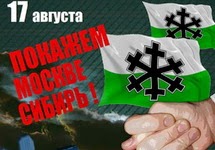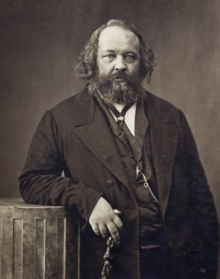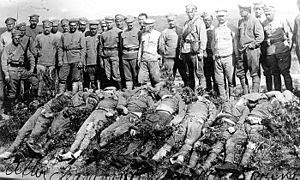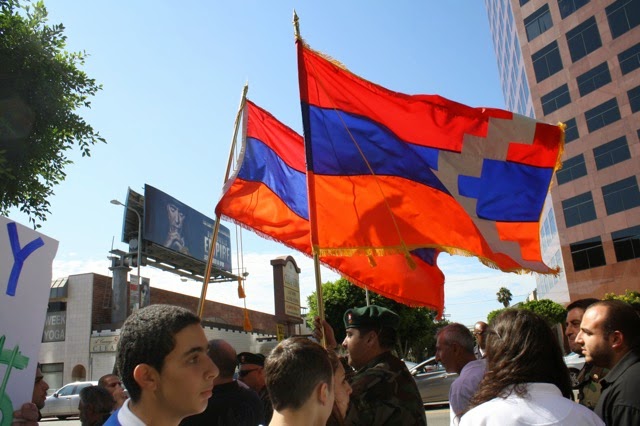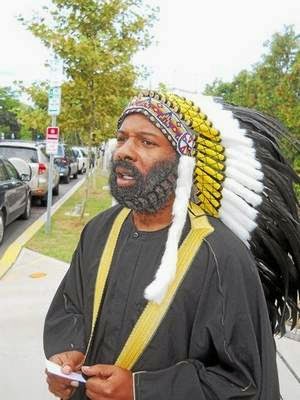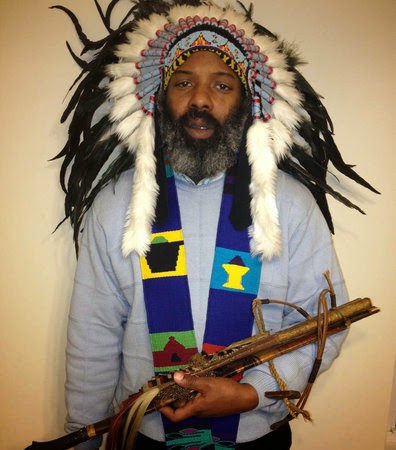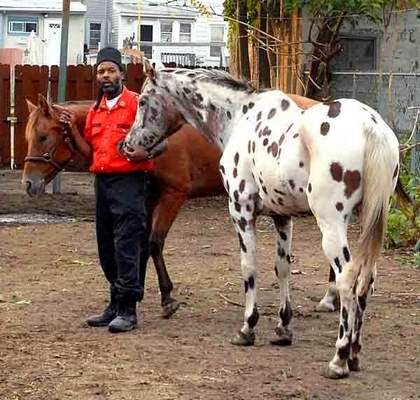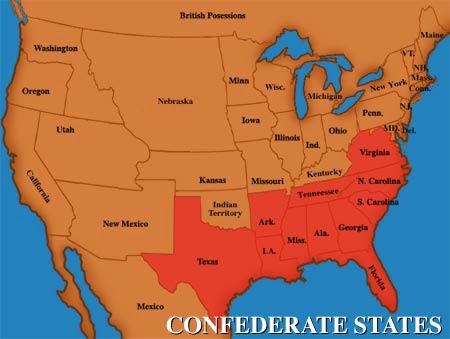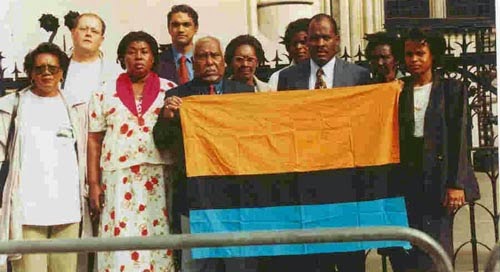The contested
United States presidential election in 2000 between
Al Gore and
George W. Bush made
Florida famous not only for ballot-box dysfunction but also for its division on a razor’s edge between
Republican and
Democratic halves, mirroring the country as a whole. A point of debate between the candidates had been climate change, which Gore, along with most educated and intelligent people, saw as a real threat and which Bush’s supporters scorned—as most Republicans still do—as a scare story in service to a liberal plot to overregulate industry. That same divide was seized upon this month by Democratic leaders in South Miami, including its mayor, as a primary reason that the southern half of the state should split away as the “
State of South Florida.”
![]() |
| Also check out U.S. Constitution, Article IV, Section 3. |
Another high-ranking supporter of partition, Vice-Mayor
Walter Harrisput it, “We have to be able to deal directly with this environmental concern and we can’t really get it done in Tallahassee. I don’t care what people think; it’s not a matter of electing the right people.” And
Robert Welsh, a city commissioner,
said, “The only time you get real cooperation from a government is when you threaten them with action.” Mayor
Philip Stoddard, a former professor of biology, added, “Our representatives aren’t paying attention to the scientists. It seems a bit quixotic, but I have been advocating separation for 15 years.” Mayor Stoddard on October 7th signed the (
very non-binding) resolution on statehood, after the municipal commissio it with a 3-to-2 vote.
![]() |
| Miami? Hm, maybe we’ll vacation in Denver this winter. |
The proposed 51st state would include 24 counties and have a capital, according to Harris, somewhere in
Orange County, near Kissimmee. The area would include the Everglades, the Florida Keys (home to the self-declared independent
Conch Republic, but that’s another story), and the larger Miami metropolitan area and reach just far enough north to take in Orlando and Tampa as well. The 24 counties make up about 39% of Florida’s land and, with 13.5 million people, constitute two-thirds of the state population.
![]() |
Key West’s self-declared Conch Republic would be part of
the State of South Florida under the new plan. |
Typically, 51st-state movements—not counting those of overseas territories like
Puerto Rico,
Guam, and
American Samoa—have a partisan dimension and in particular tend to be spearheaded by voting blocs whose minority status in an existing state effectively shut them out of not only gubernatorial elections but also indeed national politics under the non-proportional, first-past-the-post system that sends representatives to the Senate as well as to the Electoral College that elects the president. Thus,
California Republicans in that state’s rural far north (“
State of Jefferson”—sometimes taking in part of
Oregon as well) and far south (“
South California”) would like to split away to escape domination by California’s Democratic majority. Likewise for statehood movements in the “red” fringes of other “blue” states—examples including “
Western Maryland,” “
West New York,” and movements by downstate Republicans to expel
Chicago from
Illinois and upstate conservatives in
Nevada to draw a state boundary between themselves and
Las Vegas. (Since Republicans would retain the state capital, these are more properly expulsion, rather than secession, movements.)
Less numerous are blue statehood movements in red states, the most prominent of which is a push for a “
State of Baja Arizona” centered on liberal Tucson. But none of any of these proposals has any chance of success. After all, U.S. Congress has to approve any new admissions to the union, even those (like
Maine and
West Virginia, historically) which join through secession. The U.S. political system encourages closely divided legislatures, and therefore the necessary consensus to admit a new state usually occurs only when two states, one for each moiety of the political spectrum of the day, can be admitted in tandem. That pattern was inaugurated with the Missouri Compromise of 1820, in which the slave state of
Missouri and the free state of Maine were created nearly simultaneously, and continued right up to the admission of Democratic-dominated
Hawaii and Republican-dominated
Alaska in 1959. Creating a State of Jefferson would guarantee two new Republican senators on Capitol Hill, while leaving the Democratic hold on what remained of California unchanged, and Democrats would never go for that; likewise with Republican attitudes toward any talk of Baja Arizona.
![]() |
Elements in this proposed Baja Arizona flag seem designed to irk Republicans:
a French tricolore, and a saguarro cactus that looks a lot like a raised middle finger. |
So it is only in swing states that there is any chance of adding a 51st star to the flag. A premier example was last year’s “
State of North Colorado” movement, in which rural conservative counties in
Colorado’s Front Range region pushed for secession. It was a reaction not only to the formerly solidly Republican state’s becoming more and more Democratic as cities grow and
Latino immigration increases but also to its tipping far into the social-issues vanguard by decriminalizing marijuana. But Colorado’s demographics and political future are still ambiguous enough that no one in Washington is willing to risk dividing it; the status quo is a better bet. (For one thing, no one’s sure how many Hispanic voters will remain Democratic after Obamamania subsides.) Another example of a statehood movement in a swing state is a long-standing movement in
Michigan’s remote, conservative Upper Peninsula to become the “
State of Superior.” (Some Superior proposals include the northern fringes of the Lower Peninsula and the northern edges of
Wisconsin—another swing state—and mostly-liberal
Minnesota as well.) A recent proposal from the Pittsburgh suburbs to hive off western
Pennsylvania as the “
State of Westania” is less partisan in motivation: each resulting half would contain one of Pennsylvania’s large liberal cities (Philadelphia would dominate the rump eastern Pennsylvania) and thus both would likely still be swing states.
![]() |
The blue counties voted to stay in Colorado in the 2013 non-binding referenda;
the orange ones opted to become the State of North Colorado. |
But a South Florida proposal may just give Republican and Democratic leaders pause. After all, every four years each party spends enormous amounts of time and money courting votes in Florida to tip that most populous of swing states, and the most closely divided one, into one column or the other. Presidential candidates would be delighted to be able to skip the “safe” states of
North Florida and South Florida and concentrate campaigns on a smaller number of mostly contiguous key swing states like Pennsylvania,
Ohio, Michigan,
Iowa, and Wisconsin.
![]() |
Some Tea Partiers want to found a red state in the North Woods
of Michigan and Wisconsin. |
Demographically, Florida is an odd mix: part of the Deep South historically, the southern part of the state has received large numbers of retirees from the liberal north, and especially northeast (remember those thousands of Palm Beach
Jews in 2000 who apparently accidentally voted for the rabidly xenophobic third-party nut-job
Pat Buchanan?), while the presence of world-class beaches and Orlando’s
Disney World has made South Florida seem at times like a colonial outpost of California. Some South Floridians don’t even talk funny.
Cuban-Americans, arriving in a flood after the Communist revolution of 1959, are most of the state’s 18% Hispanic share and an influential force in state politics; traditionally, they have been the only reliably Republican-voting Latino population in the U.S., since Republicans have always done a better job of portraying themselves as aggressive opponents of Communism (especially after
John F. Kennedy bungled the Bay of Pigs invasion). But with the Cold War over, state socialism looking set to slide gently into
Chinese-style economic liberalization as
Fidel Castro fades away, and a younger generation feeling more American than
Cuban, Cuban-Americans, who are concentrated in and around Miami, are becoming more Democratic.
![]() |
| Ah, I’m getting all nostalgic for fin-de-siècle America! |
Even among whites, the Democratic–Republican divide does not pattern neatly into one horizontal line across the neck of Florida. Partisan differences, as elsewhere, largely follow an urban–rural split (the conservative city of Jacksonville being an exception), and, though South Florida has Miami, Tampa, Orlando, and other large cities, there are liberal pockets in the north and conservative pockets in the south as well (see map below). It’s possible that even Republicans in the south could eventually be brought around to consider the scientific consensus on climate change plausible. A couple inches of water would probably do it. After all, even Republicans in
Alaska are aware—the polar regions being a kind of canary in the mines where climate change is having the most dramatic effect—that global warming is real.
And South Florida is a very low-lying peninsula. Huge parts of it, including nearly all the southern counties that include the Everglades and greater Miami, would be underwater if sea levels rose by, say, 5 to 10 meters (see map below). No one’s predicting a 10-meter rise any time soon, but even a rise of a couple feet would destroy the Everglades and maybe prompt the abandonment of Miami—a city less easy to fortify with levees than, say, New Orleans or the coastal cities of the
Netherlands. It puts one in mind of the post-deluvian near-future southern
Louisiana depicted in the fanciful 2012 film
Beasts of the Southern Wild. It made a good movie, but life there wasn’t pretty.
The South Florida movement, then, may just be the first secessionist movement motivated mostly by fears of climate change. But a five-meter rise would change the political stakes beyond just the Sunshine State. All of coastal Louisiana would vanish, prompting a more wholesale version of what happened after Hurricane Katrina in 2005, when somewhat purplish but still mostly “red” (Republican) Louisiana ended up a more solid bright red after thousands of Democratic-leaning coastal populations like
African-Americans,
Cajuns, and urban middle-class whites fled the state for good.
As the map below shows, rising sea levels could also have effects that include disrupting democratic and economic reforms in Cuba—possibly prompting a new exodus to (what’s left of) Florida—and chaos in the
Yucatan Peninsula, a region of
Mexico dominated by
Mayan Indians, a group which spearheaded the
Zapatista anti-globalization uprising in
Chiapas and elsewhere in 1994. Oh, and one more thing: could Orlando or Atlanta or someplace please find room for the entire population of the
Bahamas?
Rising sea levels in the southern Caribbean would bring disruptions to
Venezuela’s oil industry and turn politics upside-down there, including anti-socialist (and to an extent C.I.A.-stoked) rebellions in the westernmost and most oil-rich state,
Zulia.
French Guiana’s coastline would be swallowed up, raising the question of whether
France will want to give up that lucrative colony, currently the largest remaining overseas territory of a European country other than
Greenland (which, incidentally, by this time would be independent and richer than
Kuwait due to suddenly accessible energy resources in the ice-free Arctic Ocean).
Turning to northern Europe (see below), among the cultures which might vanish if sea levels rose is the nation of
Frisia, concentrated mostly in the
Netherlands but also including parts of
Denmark and
Germany. The Dutch could protect part of their territory from the sea, but not all of it. (This could bring normally dormant interethnic tensions into relief—and we don’t even need to mention
Belgium, where most of the land swallowed up would be low-lying
Flanders.) And London, if it survives, will have to be a below-sea-level city like New Orleans, constantly worried about floods and the strength of its levees. Avoiding that stress by decamping to Brighton for the weekend will seem a less attractive option after the Gulf Stream diverts away, so maybe it’s time for a holiday in Florida—oh, no, wait, never mind.
![]()
Southern Europe would be in better shape. If the
European Union,
Israel,
Turkey, and the
Arab League pooled their resources, they could easily install locks at the Strait of Gibraltar and keep the Mediterranean Sea at any level they want, thus saving cities like Istanbul, Venice, Barcelona, and Alexandria from inundation. Suddenly, southern Europe would be the rich part of the E.U., with flood-ravaged countries like Germany and Denmark going cap-in-hand to the high-and-dry booming economies of
Greece and
Italy.)
![]() |
| The Pillars of Hercules: nec plus ultra except lots and lots of water. |
Indonesia, always kept on a boil by ethnic strife, would be tested to its limit. Though it has oil, it will have to perform a bit of triage to decide which regions to help the most.
Riau and other wealthy ethnic-Malayan/Indonesian areas on
Sumatra along the Strait of Malacca, near
Singapore, will likely get lots of economic aid and structural assistance, but expect the tribal peoples of
Papua,
West Papua, and
Kalimantan (
Borneo) to get the shitty end of the stick as usual and maybe rise up in protest. Oh, and that
South Moluccas government-in-exile in the Netherlands? It won’t be a government-in-exile anymore, but only because nearly all the residents of those now submerged islands will have to relocate to Amsterdam permanently.)
Perhaps worst off will be
Bangladesh. With more than half the U.S.’s population packed into a region of fragile deltas and sandbars the size of Wisconsin, and millions living on the brink of survival anyway, this poorest of the poor among major nations could become a demographic Cheronobyl in the middle of Asia. Already, the bloody war of independence from
Pakistan in 1971 and hopeless miring in poverty and coastal erosion since then have created an exodus of Bengali Muslims into neighboring countries. In nearby parts of
India, Hindu and Christian ethnic militias have long been itching to expel Bengalis from their territories, and in
Burma (
Myanmar) Buddhist-led pogroms against the
Rohingya people—800,000 stateless Muslims marginalized by the state as “Bangladeshi squatters”—has derailed the ruling
junta’s attempt to liberalize and present itself to the world as a responsible global citizen. Imagine what it would do to Burma and India if, instead of tens or hundreds of thousands of displaced Bangladeshis, they would be asked to absorb, oh, say,
70 million of them. Especially since Burma would be losing much of its coastline too.
Though their population is dwarfed by the countries listed above, it is possibly the minuscule nations consisting mainly of low-lying islands that have the most to fear from rising sea levels. The Bahamas in the Caribbean (see above);
Kiribati,
Nauru, and
Tuvalu in the South Pacific; and the
Seychelles and
Maldives in the Indian Ocean are among those nations which could disappear altogether if the seas rose more than a little bit. The highest Maldivean point of land is seven feet above sea level, and for several terrifying minutes during the Boxing Day tsunami of 2004 the entire Republic of the Maldives was underwater. If a situation like that became permanent, not only would there have to be material provisions made for the survival of such populations, but a whole rethinking of the idea of
nation might have to take place. Hundreds of local cultures could become like the sovereign but landless
Military Order of the Knights of Malta, or like the
Roma (
Gypsy) people, or, in a closer analogy, like the
Chagossians—the native people of
Diego Garcia in the
British Indian Ocean Territory who were deported by the British and Americans in the late 1960s and early ’70s to make way for
NATO bases and who now live mostly in the village of Crawley, in County Sussex,
England, dreaming of home and trying to keep their culture and dignity together. (See
a recent article from this blog on the Chagossians.)
![]() |
The Chagossian nation has a flag but no place to plant it.
Could Kiribatians and Seychellois one day be—pardon the expression—in the same boat? |
The people of Miami don’t want to end up like that. But the state’s Republican governor and industry-bought-out power-brokers (of both parties, incidentally) will not help them prepare for coming changes. As Mayor Stoddard told a reporter, “It’s very apparent that the attitude of the northern part of the state is that they would just love to saw the state in half and just let us float off into the Caribbean.” I guess North Florida should be careful what it wishes for: if South Florida secedes, it will take most of Florida’s economy with it.
![]() |
| “It’s a small world after all” ... you know, especially the land part of it |




























